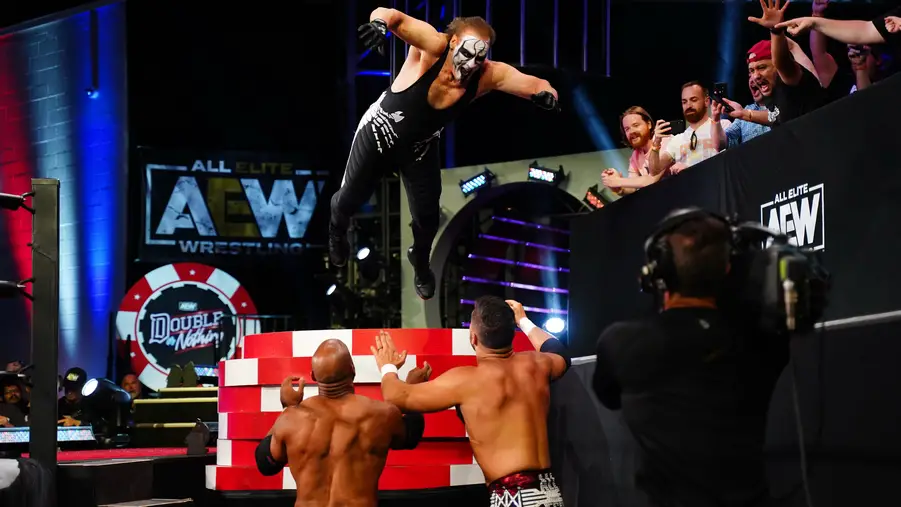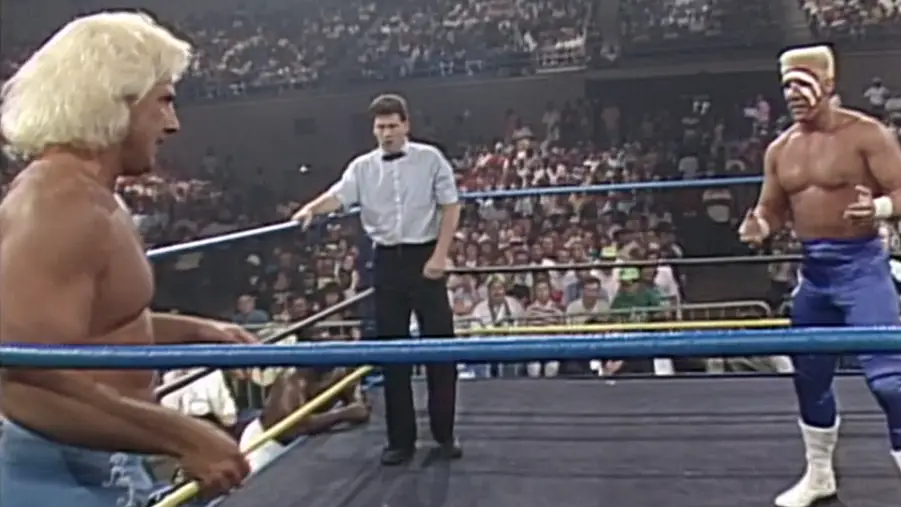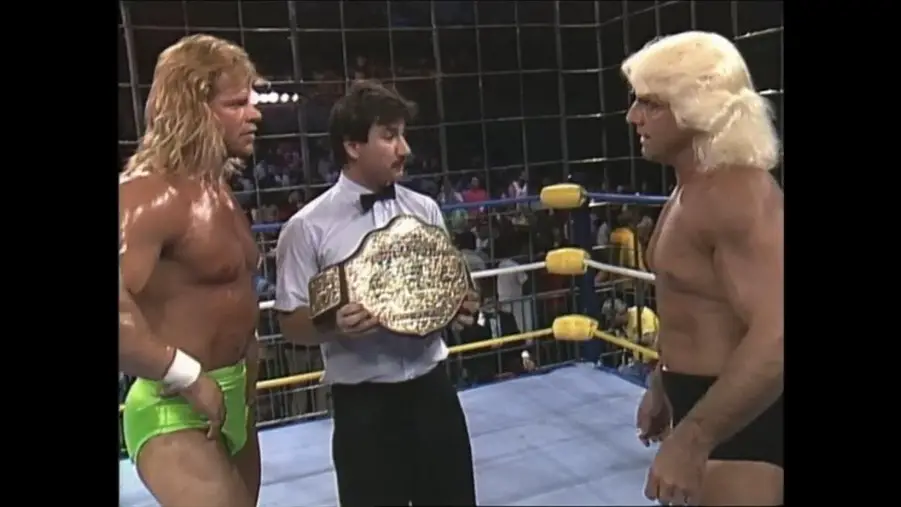How Sting's Ageless AEW Comeback Parallels His 1990 Triumph Over Ric Flair
"The Icon" was overcoming adversity long before Double or Nothing
Feelgood debuts and returns were aplenty at AEW's Double or Nothing a little over one week ago. It was a night of continuous good vibes in this, the ongoing reclamation of normalcy.
No return was as welcome as that of the packed AEW crowd, a vociferous lot of approximately 5,200 revellers. While All Elite Wrestling has remained a strong product for much of the pandemic, the loud crowds were a conspicuously-missing ingredient. I'd wager they deserve to win "Comeback of the Year" in various year-end voting forums, solely based on the difference they made in just one pay-per-view.
While the return of the vociferous fanbase was a welcome one, it wasn't the only awing comeback on the night.
To see 62-year-old Sting stave off the passage of time (and what was once deemed a career-ending cervical injury), to perform the way he did, was an absolute treat.
The Stinger's big spots may have been strategically spaced out in the tag team match that pitted he and Darby Allin against Scorpio Sky and Ethan Page, but that hardly mattered.
There's just something about seeing pro wrestling's 'Dark Knight' fire off Stinger Splashes, leap from the stage, and even perform a good-enough rendition of the Code Red, that warms the soul of an aging fan.
The best part is seeing Sting do it on his own terms.
By retiring at 56 due to a serious spinal issue, it was a reminder that the man beneath the paint is as fallible as any of us. He may be a superhero when he steps between the ropes, but mild-mannered Steve Borden is, in fact, human after all.
Human enough to where we all held our breath when Sting allowed Brian Cage to powerbomb him earlier this year.
And yet, his return feels like the Sting that many of us grew up with - the immortal defender of truth that doesn't die so easy.
A little over 30 years ago, that Sting experienced one of the greatest triumphs of his career - and he did it (coincidentally) coming off of a major injury.
We're talking the *old* Sting - that bleach-blonde, surfer-bodied, neon-adorned Sting that would rather pump iron on Venice beach than brood among the shadows, bat in hand. The Sting that could win the heart of a sworn WWF fan, by melding the best qualities of Hulk Hogan (positive energy, heroic disposition, valiance in battle) and The Ultimate Warrior (a face-painted enigma, though a coherent one).
When NWA/WCW matched up Sting against World champion Ric Flair for the first time in 1988, they already knew there was something special about the California bodybuilder. But after the two battled to that 45-minute time limit draw, the organization had a certified star on their hands.
Ever the ring general, Flair gave everything to Sting in the name of parity, and the fans in Greensboro, NC came to buy the war-painted upstart as an uncrowned champion - one they could absolutely get behind.
Incredibly, it took over two years for Sting to nab the top prize.
But the wait proved worth it.
Sting's popularity continued to grow over the ensuing year and a half, entrenching himself as a franchise cornerstone. He crossed paths with the "Nature Boy" in many untelevised bouts throughout 1988 and 1989, as Flair helped Sting continue his development as a performer.
By the end of 1989, the wheels were in motion for Sting and Flair to oppose each other in the promotion's main rivalry.
By this point in time, Flair had turned himself babyface, on the strength of his legendary battles with Ricky Steamboat over the championship that year, followed by a violent feud with Terry Funk. He was still the high-rolling, supremely-confident World champion, but at this point, he was on the side of good.
In fact, in late 1989, the world was getting a babyface version of The Four Horsemen. Flair was flanked by old allies Arn and Ole Anderson (seemingly the antithesis of "babyfaces"), and, in a total surprise, Sting himself.
The group battled Gary Hart's villainous J-Tex Corporation, but still, The Horsemen as good guys just didn't seem to fly right.
The universe properly re-aligned at the February 1990 Clash of the Champions, when Sting dared to ask Flair for a World title match, a challenge among competitive allies. The other Horsemen showed their glaringly-true colors by beating Sting down after he refused to rescind his challenge.
Sting would attempt his revenge later that night. With the other Horsemen facing the J-Tex Corporation in what was now a rather odd heel vs. heel cage match, Sting stormed the battlefield, attempting to climb inside to get his hands on Flair. Brian Pillman and a group of officials tried to restrain Sting, pulling him down from the cage wall, when something unfortunate happened.
In getting yanked down, Sting took an awkward step, and wound up blowing out his knee.
The planned title match for WrestleWar (just three weeks later) was now out the window, as Sting faced a considerable recovery time.
To make up for Sting's absence, United States champion Lex Luger was slotted into the match with Flair, the next most realistic challenger for "Naitch".
While Luger felt more like a means to an end, there were actually plans to have "The Total Package" defeat Flair to win the title.
According to Flair, WCW Vice President Jim Herd was furious over Sting managing to get hurt at the worst possible time, and tried to authorize the switch to Lex.
However, Flair refused, having promised Sting that he would only drop it to him. It also made the most sense, since the heat for the Horsemen double-cross was immense, and Sting was clearly the top babyface in the company.
As Flair noted, "Sting's knee would heal soon, I told Herd, and it was stupid to change course now."
Sting's date with destiny would finally come at the 1990 Great American Bash in Baltimore, on July 7 of that year. In all, Sting missed about five months of action, and Flair remained champion all the while, his reign reaching 14 full months.
In a year where The Ultimate Warrior dethroned Hulk Hogan, Demolition won their third WWF World Tag titles, and The Road Warriors jumped to the grand WWF stage, momentum seemed to favor the face-painted hero.
Sting's allies from the short-lived "Dudes with Attitudes" stable would surround the ring to prevent any Horsemen chicanery. Meanwhile, Horsemen puppet master Ole Anderson was handcuffed to the towering El Gigante on the entrance stage.
The challenger (resplendent in patriotic make-up and attire) puffed out his chest and took the fight to Flair early, overpowering the veteran. Meanwhile, Flair tried gaining the advantage at every turn by going for the repaired knee. Then, in a pretty nice irony, Flair missed a knee drop, and wound up snared in his own Figure Four by Sting. The champion eventually made the ropes, but with every passing minute, the fans could sense the title change.
Flair failed to properly exploit the knee, setting up Sting for a major flurry: a Stinger splash, followed by the Scorpion Death Lock. From the stage, a restrained Ole could do nothing - nor could Arn, Barry Windham, or Sid Vicious when they tried storming the ring, as the babyface brigade blocked their path via standoff.
The Baltimore crowd was madly yearning for Flair to give up, but it wasn't over yet - he managed to get the ropes once more.
Sting continued his attack. However, when he attempted another Stinger splash, Flair moved, causing Sting's surgically-repaired knee to smash into the buckle.
Seeing his opening, Flair went for the Figure Four, only for Sting to pull him into an inside cradle, netting the Stinger the first of his 14 World titles.
Jubilation aside, the reign that followed was not an ideal one for Sting. There wasn't much in the way of convincing heel challengers for his gold, as he was saddled with Sid Vicious and the hokey Black Scorpion fiasco. He ultimately dropped the title back to Flair in January of 1991.
Nonetheless, Sting's moment of ascension remains one of the defining images of the time. For a WCW doing all it could to legitimize itself as a genuine national product, there was no better choice for face of the company.
And the fans, they rejoiced when Sting got his moment in the sun. While the knee injury was not ideal, it actually enhanced his triumph. Like the hero he was scripted to be, Sting overcame a major real-life obstacle on the way to his crowning achievement, the way a true top-level star would.
While a blown-out knee is less likely to be a career-ender than a cervical fracture (especially when the former happens at 30 and the latter at 56), I couldn't help but draw that parallel for a man that, on Sunday night, May 30, defied physical expectations in front of the hottest wrestling crowd we've seen in a good long time.
Sting is certainly larger than life, though the real superhuman is Steve Borden. He's still able to do Sting-like things deep into his middle age, without looking the slightest bit out of place.
And when Sting's kicking the asses of the presiding villains, you know things are truly back to normal.




